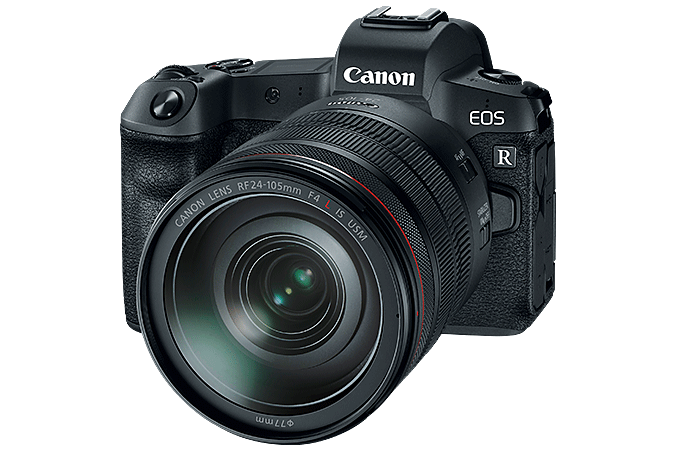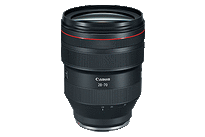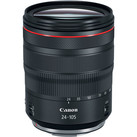Diving into the details of the EOS-R’s video capabilities, we find up to 4K resolution (UHD 3840x2160) at 30 fps, with 10-bit 4:2:2 output on the 4K-capable HDMI port. Canon Log and BT.2020 color space are supported as well. On the EOS-R, Canon Log will yield as much as 12 stops of dynamic range at ISO 400. In other shooting modes, full HD (1080p) goes up to 60 fps, and 120 fps is possible at 720p. Canon’s Movie Digital IS (digital image stabilization) is present as well. Both a microphone input (3.5mm stereo mini jack) and headphone jack are present. Internal recording is to a single UHS-II SD card and can use Canon’s well-executed All-I (intra-frame) codec at up to 480Mbps and their IPB (inter-frame) codec at up to 180Mbps. Both are MP4-wrapped versions of the H.264 codec family. For classification purposes, maximum record time is limited to 29 minutes and 59 seconds like most other mirrorless cameras. The battery included is Canon’s familiar LP-E6N.

The new lens mount is dubbed ‘RF’ (in contrast to Canon’s venerable full format EF mount, which debuted back in 1987). The new mount features the same diameter as the EF mount (54mm, capable of supporting ultra-wide apertures without vignetting from the body) but a vastly reduced flange focal depth (also called registration distance or back focus distance) of only 20mm, less than half of the EF standard’s 44mm. This is very similar to the flange depth of Sony’s E-mount (18mm) and other mirrorless cameras, which should make for easy adapting of manual stills lenses from classic camera systems (including, of course, EF lenses — more on that below) but also for the first time Canon’s formerly penultimate mount, FD.
Speaking of adapters, perhaps the most-adapted lenses to mirrorless camera systems are Canon’s widely-owned EF lenses. Since all but a few EF lenses are completely electronically controlled, adapting them to other mirrorless cameras has meant relying on third-party parts with greater or lesser (often lesser) reverse-engineered implementations of Canon’s EF protocol. The good news for the EOS-R system is that Canon has produced their own first-party smart adapters for the new camera, which we think it's safe to say will provide the best EF lens experience on mirrorless. There are three adapters (all maintain autofocus and image stabilization if present in the adapted lens): a standard EF-to-RF adapter, another featuring a configurable control ring as seen on the new EOS-R lenses themselves (see below), and lastly one encapsulating a nifty behind-the-lens, drop-in filter system allowing variable neutral density and circular polarizing filters to be manually rotated.
However, you may find that you do not need to adapt any lenses, as the EOS-R system arrives with four new lenses, including two zooms and two primes covering the most critical focal lengths and fields of view for both stills and motion on full format. First is a new version of the standard “go to” midrange zoom, this one covering 28mm-70mm with an unusually fast f/2 maximum aperture. Also available is a 24-105mm f/4 zoom (with image stabilization). An ultra-fast f/1.2 50mm and f/1.8 35mm prime round out a compelling range of native glass for the system. All but the 35mm f/1.8 receive the red ring synonymous with the ‘L’ designation given to Canon’s professional-level lenses. Additionally, all RF lenses feature a customizable control ring at the front of each lens (interestingly, this is where classic rangefinder lenses often placed their iris rings). The ring can be set to control a number of different camera and lens functions such as aperture, exposure compensation, ISO and others.
Back on the camera body, the rear thumb rest is a multi-function bar, which can recognize a tap on the right or left as well as a swipe gesture, allowing multiple functions to be executed from a single control interface. These include ISO, autofocus mode, white balance, and more. One of the biggest features inside the camera is Canon’s state-of-the-art Dual Pixel CMOS autofocus. As with cameras like the C200 and C300 Mark II, Canon's autofocus is by far the best of any video-capable “hybrid” camera, and here is paired with a full format sensor. When addressing the entire sensor, an astonishing 5,655 individual points are selectable and focus can be acquired in as little as 0.05 seconds. With RF (and select EF) lenses, autofocus points cover 88% of the EOS-R sensor’s width and 100% vertically, allowing autofocus virtually anywhere in the frame. With the fastest RF and EF lenses (the latter via adapter) autofocus can function from an amazing -6 EV wide open (equivalent to a light level of some four hundredths of a Lux) all the way to f/8 and f/11 (with compatible lenses).
If you’ve used face tracking autofocus on a Cinema EOS camera you know how useful it can be in single-operator interviews or other run-and-gun shooting situations. The implementation on the EOS R is Canon’s Face+Tracking type, which extends to using the subject’s eye as the autofocus point. Which eye you ask? By default, it’s the one closest to the camera, but it’s also selectable by either using the camera’s AF point selection button or simply tapping the articulating rear touchscreen. What’s more, the touchscreen can also be used for what Canon calls Touch and Drag AF, which intuitively allows for focus to be racked between, for example, a face in the foreground to one in the background.
We’re just starting to see what’s possible with the exciting new EOS-R camera system. Stay tuned for much more once we get the chance to put the camera through its paces!
Pre-orders will begin on September 12, 2018 and pricing is set at $2299 for the EOS-R body alone and $3399 with the 24-105mm f/4L lens. General availability is expected in October.













